
The shot put is a track and field event involving "putting" (throwing) a heavy spherical ball—the shot—as far as possible. For men, the sport has been a part of the modern Olympics since their revival (1896), and women's competition began in 1948.

The hammer throw is one of the four throwing events in regular outdoor track and field competitions, along with the discus throw, shot put and javelin.

Highland games is a competitive strength sport with events held in spring and summer in Scotland and several other countries with a large Scottish diaspora as a way of celebrating Scottish and Celtic culture, especially that of the Scottish Highlands. Certain aspects of the games are so well known as to have become emblematic of Scotland, such as the bagpipes, the kilt, and the heavy events, especially the stone put, Scottish hammer throw, weight throw, weight over bar, caber toss, keg toss and sheaf toss. While centred on competitions in piping and drumming, dancing, and Scottish heavy athletics, the games also include entertainment and exhibits related to other aspects of Scottish and Gaelic cultures.

Strength athletics is the collection of strength sports which measure physical strength, based on both: non-standard and historical implements as seen in Strongman and Highland games, and standardized and calibrated equipment as seen in Powerlifting and Weightlifting.
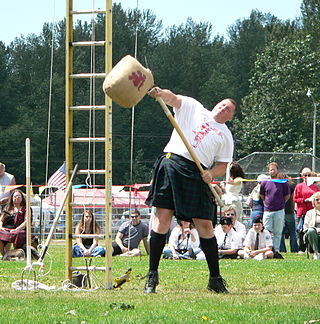
The sheaf toss is a traditional Scottish agricultural sport event originally contested at country fairs. A pitchfork is used to hurl a hessian bag stuffed with straw over a horizontal bar above the competitor's head. Typical weight for the bag is 16 or 20 pounds. Three chances are given to each competitor to cleanly go over the bar. After all challengers have made their attempts, the bar is raised and all successful competitors move on to the new height. This continues until all but one athlete is eliminated.

Geoffrey Lewis Capes JP was a British shot putter, strongman, and Highland Games competitor. He was famous in the UK in the 1980s for his sporting prowess and appearances on television in shows such as Superstars and the World's Strongest Man.
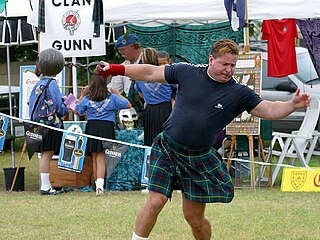
Two sports have events that fall under the name of weight throw one being the track and field event and the other being the Scottish highland games events.

Unspunnenfest is a festival held in the town of Interlaken, Switzerland, near the old ruin of Unspunnen Castle, in the Bernese Alps, approximately once every twelve years, most recently in 2017. The festival highlights traditional Swiss culture and features competitions of Steinstossen, Schwingen (wrestling) and yodeling. The stone-throwing competition uses an 83.5 kg (184.1 lb) stone known as the Unspunnenstein, made of Aare granite from the Hasli valley.
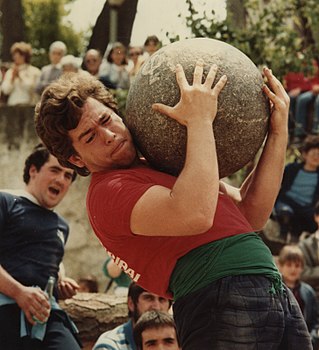
Lifting stones are heavy natural stones which people are challenged to lift, proving their strength. They are common throughout Northern Europe, particularly Iceland, Ireland, Scotland, Basque Country, Faroe Islands, Wales, North West England centered around Cumbria, Switzerland, Southern Germany centered around Bavaria, Austria, Scandinavia and also in the United States and parts of Asia such as Japan.

Burger Lambrechts is a South African shot putter.
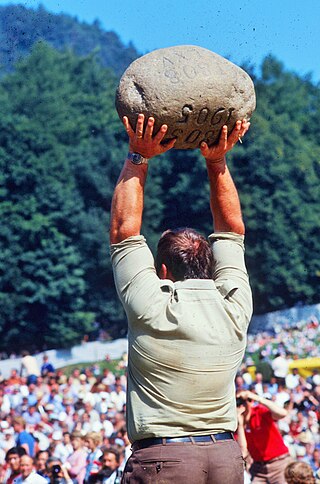
Steinstossen is the Swiss variant of stone put, of throwing a heavy stone overhead using both arms for the longest distance. Practiced among the alpine population since prehistoric times, it is recorded to have taken place in Basel in the 13th century. During the 15th century, it is frequently recorded to have been practiced alongside the Schützenfeste of the Old Swiss Confederacy.
Brian Oldfield was an American athlete and personality of the 1970s and early 1980s. A standout shot putter, Oldfield was credited with making the rotational technique popular. With his "Oldfield spin," he set the indoor and outdoor world records in the sport many times. However, due to his status as a professional athlete, and due to the lack of official control of his achievements by athletic authorities as well as later steroid-related investigations, his records were never officially recognized.
Margaret "Meg" Elizabeth Stone is a retired Scottish discus thrower and Shot putter. She reached the Olympic finals at discus in Moscow 1980 (9th) and Los Angeles 1984 (5th). She also won the 1982 Commonwealth Games title. Her discus best of 67.48 metres has stood as the British record since 1981, while her shot put best of 18.99 metres has stood as the Scottish record since 1983.
Pétur Guðmundsson is a retired shot putter and Highland games competitor from Iceland. He represented Iceland at the 1988 Summer Olympics and 1992 Summer Olympics. He is a police officer by profession.

The Highlander Challenge World Championships is a tournament that marries traditional Highland games with more contemporary strength athletics. It was created to help reinvigorate Highland games in Scotland by giving a modern and aspirational image while maintaining the tradition inherent in the history of the sport.
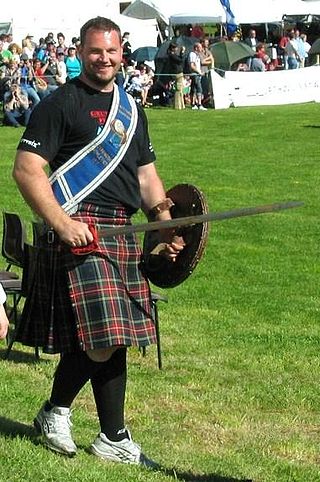
Gregor Edmunds is a Scottish Highland Games competitor and strongman. Gregor is a winner of the World Highland Games Championships, world record holder in Highland games throwing the 28lb weight 95’10.5" Highlander Challenge, and Scotland's Strongest Man.
Andrés Guðmundsson is an Icelandic Strongman and Highland Games competitor. He held the titles of the World Strongman Challenge and the European Hercules.
Hjalti 'Úrsus' Árnason, is an Icelandic former strongman competitor and world champion powerlifter. Known by the nickname 'The Great Ursus', Hjalti first began in strength sports by competing as a junior powerlifter in 1983. He also coached Jón Páll Sigmarsson and won the 1988 Le Defi Mark Ten International. Hjalti also competed with Magnús Ver Magnússon in Pure Strength team competitions in 1989 & 1990.

The Húsafell Stone is a legendary lifting stone weighing 186 kg (410 lb) located in a west country farming estate in Húsafell, Iceland about 132 km (82 mi) northeast of Reykjavík. The slightly triangular, slab shaped stone is kept at a sheep and goat pen built from natural stones by Reverend Snorri Björnsson around 1756, and was made famous by the legend of his daughter Guðný Snorradóttir carrying it. The stone has been used as a test of physical strength by either simply lifting the stone, or by lifting and carrying it around the sheep and goat pen. The stone is also known as pen slab (Kvíahellan in Icelandic), because its original purpose was to act as the gate to the sheep and goat pen, ensuring the animals remain in the pen without escaping.
Weight over bar is a traditional strength sport derived from ancient Scottish Highland games that involves the heaving of a 25.5 kg (56 lb) weight, over a bar using one hand. Unlike its other counterpart, the Weight throw which involves a full body rotating spinning technique, the Weight over bar requires the weight to be kept between the legs before swinging it up in a pendulum like manner, and releasing when it is at its apex, directly overhead.



















